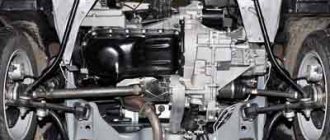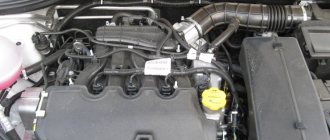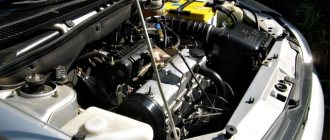November 26, 2014 Lada.Online 183 301 3
The Lada Granta is a budget front-wheel drive car that was developed on the basis of the Lada Kalina. Sales of the car began at the end of December 2011. Currently, 5 types of engines are installed on Lada Granta/Kalina 2:
- VAZ-11183-50 (82 hp)
- VAZ-11186 (87 hp)
- VAZ-21126 (98 hp)
- VAZ-21127 (106 hp)
- VAZ 21126-77 (120 hp)
Despite this diversity, the volume of all engines is the same and is 1.6 liters.
For an increase of 3 hp. and 3 Nm, a large-scale modernization is hidden in the VAZ-11182 engine.
Lada Granta with a new engine: how does it drive? what resource?About modern VAZ engines
The manufacturer offers a choice of two 8 valve engines :
- VAZ-11183-50 (82 hp) is a modified VAZ-2111 engine, as a result of which environmental performance has increased, the engine has become more reliable and less capricious. It also has the advantage of elasticity and traction. Disadvantages include periodic valve adjustments and noisy engine operation. If the timing belt breaks, the valve does not bend.
- VAZ-11186 (87 hp) is a modified VAZ-21114 engine, as a result of which it was possible to reduce noise and gasoline consumption. Environmental friendliness has improved and power has increased noticeably. Disadvantages: compared to the VAZ-11183, this engine has a shorter service life. When the timing belt breaks, the valves bend.
16 valve engines :
- VAZ-21126 (98 hp) is a continuation of the VAZ-21124 engine and is currently one of the most advanced domestic engines. Disadvantage: valve bends when the timing belt breaks.
- VAZ-21127 (106 hp) is a modified VAZ-21126 engine. In comparison, the engine has become more torquey at the bottom, the changes are minor, but noticeable. The disadvantages include bending of the valves when the timing belt breaks.
Description
The Grant engine is a modernized version of the long-produced engines 21124 and 11183. It differs from its predecessors by the presence of a 39% lighter connecting rod and piston group developed by Federal Mogul. For the VAZ-11186 engine it is manufactured directly at AvtoVAZ OJSC.
As a result of the modernization, significantly:
- power increased;
- exhaust toxicity has decreased;
- fuel consumption has decreased.
The cylinder head has become much stronger, since during manufacturing it undergoes a special heat treatment cycle. In addition, it is further strengthened by metal gaskets.
Despite the fact that all the motors in the line are assembled according to an identical design, the 11186 engine has a number of design features. Among them are:
- Improved cooling system for the block and cylinder head. The piston group is covered with a cooling jacket along its entire height and is equipped with piston cooling nozzles, which prevents deformation of the cylinder block due to uneven heating.
- Using a new camshaft drive design equipped with an automatic tensioner.
- The original design of the crankshaft, equipped with special oil channels, which are closed with plugs. This required the use of high-strength cast iron for its manufacture.
A significant drawback of the grant engine is that if the timing belt breaks, the valves bend, which can lead to failure of the power unit as a whole (breakage of pistons and cylinders). In order to protect the engine, a highly reliable drive belt is installed at the manufacturing plant during assembly, which is manufactured by the American company Gates Rubbler Company. The service life of this belt is at least 200 thousand kilometers.
Interesting: As a result of modernizing the VAZ-11186 engine, it became possible to equip it with an electric throttle valve drive (E-gas). This allows you to increase its power to 90 hp. With.
Lada Granta engines 16 valves
This engine is also equipped with a lightweight piston group manufactured by Federal Mogul and a belt with an automatic tensioner from Gates. It is distinguished by a 16-valve head with a pair of camshafts and hydraulic compensators, due to which its power is significantly higher.
All the problems of its predecessors apply to this unit in full. The engine often suffers from lubricant leaks, tripping, floating speed, sensor glitches and valve burnout. Plus, you can add hydraulic compensators that are very demanding on oil quality.
Hatchback before restyling 2015 - 2019
| 1.6 l 21126 MKP5 | 1.6 l 21126 automatic transmission4 | |
| Type | injector | injector |
| Fuel | gasoline AI-92 | gasoline AI-92 |
| Location | transverse | transverse |
| Cylinders | 4 in a row | 4 in a row |
| valves | 16 | 16 |
| Working volume | 1596 cm³ | 1596 cm³ |
| Power | 98 hp | 98 hp |
| Torque | 145 Nm | 145 Nm |
| Acceleration to 100 km/h | 11.2 s | 13.3 s |
| Speed (max) | 182 km/h | 173 km/h |
| Ecological Class | Euro 5 | Euro 5 |
| Consumption city | 8.8 l | 9.9 l |
| Flow track | 5.6 l | 6.1 l |
| Mixed flow | 6.8 l | 7.2 l |
All technical characteristics of the engine are described on the Motor VAZ portal
The updated engine received an adjustable intake tract with dampers in the receiver channels. Also here, the mass air flow sensor gave way to a combination of absolute pressure and air temperature sensors, thanks to which the frequent problem of floating speed at idle has finally gone away.
The reliability of the new unit has increased, although it is not flawless. The thermostat also often fails, the injectors become clogged, and the ignition system malfunctions. But the main threat is the water pump, because of the wedge of which the timing belt breaks and the pistons meet the valves. Update: In July 2022, the manufacturer equipped this engine with plugless pistons.
Hatchback before restyling 2015 - 2019
| 1.6 l 21127 MKP5 | 1.6 l 21127 AMT5 | |
| Type | injector | injector |
| Fuel | gasoline AI-92 | gasoline AI-92 |
| Location | transverse | transverse |
| Cylinders | 4 in a row | 4 in a row |
| valves | 16 | 16 |
| Working volume | 1596 cm³ | 1596 cm³ |
| Power | 106 hp | 106 hp |
| Torque | 148 Nm | 148 Nm |
| Acceleration to 100 km/h | 10.9 s | 12.3 s |
| Speed (max) | 183 km/h | 180 km/h |
| Ecological Class | Euro 5 | Euro 5 |
| Consumption city | 8.6 l | 9.0 l |
| Flow track | 5.6 l | 5.2 l |
| Mixed flow | 6.5 l | 6.5 l |
All differences from its predecessors are described in one of the blogs on Drive 2
Source
Malfunctions
The VAZ-11186 engine is characterized by malfunctions that are inherent in almost all engines developed and manufactured at AvtoVAZ OJSC.
| FAULT | CAUSE | REMEDY METHODS |
| The motor does not warm up to the required temperature (95 degrees Celsius). | The thermostat has failed. | Replace thermostat. |
| Extraneous noises and knocking. | 1. Wear of the crankshaft main bearings. | Replace worn components and parts. It is recommended to carry out repairs at specialized service stations. |
| 2. Wear of connecting rod bearings. | ||
| 3. Pistons knock. | ||
| Unstable operation of the power unit (“speeds float”, “troits”, etc.) | 1. The throttle position sensor is faulty. | Ÿ Replace the faulty sensor. Ÿ |
| 2. The valve has burned out. | Measure compression in cylinders. If it is below normal, then the gas distribution mechanism is faulty. If compression is normal, the ignition module is faulty. | |
| 3. The gasket has broken. | ||
| 4. The ignition module has failed. |
Alternative engines
VAZ-21904
VAZ-21904 is a gasoline-powered sixteen-valve turbo engine with a displacement of 1.4 and a power of 163 hp. In addition, it is equipped with a lithium-ion battery and an electric motor. The basis for it was the VAZ-11194 engine; it was installed on Lada Kalina cars in the first generation. As for the VAZ-21904 itself, it is installed on Grant hybrids - VAZ-21904 sedans. The Volzhsky Automobile Plant tested four such vehicles equipped with three different hybrid engine options.
Fifth gear was replaced by the shaft of a robotic gearbox; it rotates thanks to a small electric motor with a power of 11 kW. This option turned out to be simpler and cheaper than using the standard scheme with the electric motor located between the gearbox and the internal combustion engine. Thus, there are four gears left, but this aspect will not create any problems for the car owner - the maximum speed (160 km/h) is achieved by the car in fourth gear.
Also, the terms of reference required the developers to fulfill two mandatory conditions - charging a hybrid car from electrical networks used in everyday life and the ability to move it in two modes at once - combined and electric. AvtoVAZ’s partners in the development of electronics were the Russian research institute NAMI and the Ricardo company from the UK. It was NAMI that developed the battery and electric motor for a hybrid car.
The car is capable of starting to move purely on electric power, with the internal combustion engine switched off. During the process of gaining speed, the gear shift will be carried out by a “robot”, and the precise output of the electric motor is responsible for synchronizing the rotation of the gears at this moment. When you start the gasoline engine, the car will begin to work in hybrid mode - with the same gear shifting, in which the electric motor will either help rotate the input shaft of the box, or will switch to generator mode, charging the battery.
According to tests, a hybrid car will consume 21% less fuel than a Granta with a conventional 1.6 engine. (measurements, of course, were carried out in a gentle mode, but the result obtained is very good).
Of course, only a few hope that the hybrid Lada Granta will be in great demand and will be able to generate any significant interest in the car market in the near future. At the moment, such vehicles are nothing more than a kind of aggregate carriers intended for testing various components separately. If we talk specifically about the hybrid type transmission, its serial production will begin in at least two to three years, and it will be installed on quite expensive Lada cars, most likely C-class. Thus, it is quite possible over time and we should expect an increase in demand for hybrid cars, but the main condition for this is a fundamental change in the attitude towards “ecological” transport not only of motorists, but also of the state, as well as the vehicle manufacturers themselves.
Features of 21129 engine/differences
The main feature of the 129 engine is the “innovative” for AvtoVAZ installation of an intake receiver with variable chamber geometry and volume. Due to the damper, the volume of the intake chamber changes depending on the speed. As practice shows, the damper is activated at 3500 engine speeds.
In addition, the engineers managed to get rid of the mass air flow sensor - mass air flow sensor. Along with him, his ailments went away, which tormented the owner of the 21126 engine: unstable idling, sometimes exorbitant consumption, high cost. Instead of mass air flow sensors, engineers installed a connection from DBP and DTV sensors (atmospheric pressure and air temperature sensors). This is where the differences from the 126 engine end. Speaking in fact, the intake system with variable geometry is as old as the world and has been installed by global manufacturers almost since the 80s.
Differences 21129 from 21126 (mounted layout, transition from mass air flow sensor to DBP+DTV, presence of an intake receiver with variable geometry.
Differences between 21129 and 21127 (Different layout, different firmware)
New 8-valve VAZ-11182
In 2022, AvtoVAZ introduced a new engine for the Lada Granta FL. This is AR16SEg2 or VAZ-11182. Its main feature is an increase in torque. At 1000 rpm, 80% of the torque is already available.
Design changes include:
- renewal of the connecting rod and piston group;
- modernization of the gas distribution mechanism;
- crankshaft modernization.
Advantages of VAZ-11182:
- reduced consumption;
- reduction in switching frequency;
- no need to adjust valves up to 90,000 km;
- groove;
- absence of oil drips due to six-bolt fastening of the oil cap and improved design of the silicone gasket;
- use of Renault spare parts;
- resource 180,000 km.
Disadvantages of the VAZ-11182:
- lack of hydraulic compensators;
- complicated valve clearance adjustment (at a mileage of 90,000 km);
- increased compression ratio, for better torque you will need to fill in AI-95;
- high cost of spare parts.










